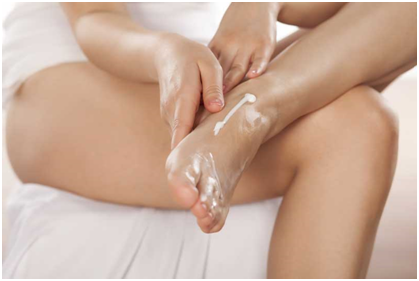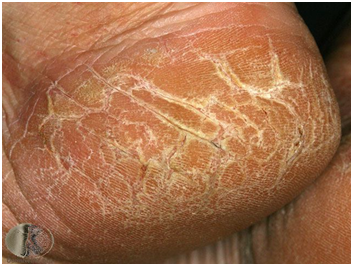Do your feet seem to sweat more than others? Do they regularly carry an unpleasant…
What are the best moisturisers to use on my feet?
Foot lotions and moisturisers, heel creams and balms, and body oils…there are so many foot care products on the market these days that we can get overwhelmed by choice. So much so, that we either avoid moisturising our feet altogether or end up spending hundreds on products we never use. So what is the best moisturiser to use on my feet?

“Podiatrists call splits or cracks in the heels ‘fissures’.”
Dry, cracked, calloused heels and feet can be incredibly painful, which if left untreated, can lead to bleeding and even infection. Podiatrists call splits or cracks in the heels “fissures”.
Listed below are some of the reasons why we can develop cracked heels:
· Skin conditions such as hypohidrosis, psoriasis and eczema
· Some types of medication cause general skin dryness (eg. steroids)
· A deficiency of omega-3 fatty acids and/or zinc
· Being on your feet for extended periods of time
· Always wearing open-back shoes
· Lack of vitamins and minerals
· Wearing unsuitable footwear
· Being overweight
· Having diabetes
· Dry/warm climates
“Increasing your fluid intake and frequency you apply moisturisers can help avoid deep cracks developing”
It is best to start treatment of cracked heels before symptoms begin by moisturising daily after showering. If you notice the skin on your heels is itching and starting to peel, increasing your fluid intake and the frequency you apply moisturisers can help avoid deep cracks developing. However, if you already have cracked heels, don’t despair. There are many things that you can do to help alleviate this problem which does not cost the earth.

What to look for when buying a foot care product:
“Treatments for cracked heels are made up of two different products, occlusives or humectants”
It is suggested that you use products that contain a high percentage of synthetic urea or glycerine. These ingredients are very effective in helping resolve dry skin problems as this type of product adds moisture to a dry area. Treatments for cracked heels are made up of two different products, occlusives or humectants, and in some cases, both. Occlusives work by providing a layer of oil on the surface of the skin to slow water loss which increases the moisture content of the skin. Humectants work by increasing the water-holding capacity of the skin. Ointments are the most occlusive products, followed by creams, then lotions and then finally oils. Ideally, for cracked heels; an ointment would be the best treatment to use, however, there is no ‘‘right’ recommended for all people- the most suitable one is often found by trial and error.
Products available in New Zealand ideal for dry, sore and cracked heels:
Sorbolene cream is a good all-round moderate-strength moisturiser that suits many patients because it is non-greasy, cheap and available in bulk without prescription.
Eulactol Heel Balm
Ego QV Cream or lotion
Cetaphil cream or lotion
Vasoline intensive care- especially the ones which contain a higher level of Vitamin E
The Body Shop peppermint cooling lotion -peppermint is rich in menthol oils that soothe dry skin and help reduce inflammation.
Lucas Papaw Ointment- natural remedy
Trilogy Everything Balm
“Natural oils are excellent moisturisers for your feet”
Natural oils are excellent moisturisers for your feet- extra-virgin olive oil, coconut oil, almond oil, sesame oil or jojoba oil. The oils listed below also provide specific therapeutic qualities:
• Argan oil for extra healing
• Tea Tree oil for antiseptic properties
• Vitamin E oil for extra skin nourishment
• Lavender oil for antifungal and soothing properties
No matter what type or combination of oil you choose, be sure to massage it into the skin deeply. Massage helps stimulate blood circulation, and that promotes healthy skin.
Looking after your feet:
Apply moisturisers each night, paying special attention to the heels. Put some socks on or wrap your feet in glad wrap overnight. Apply moisturisers as soon as you get out of the shower when the bottoms of your feet are still a little bit damp. When your feet are cracked, apply moisturiser to your feet, ideally two times a day.
Can’t reach your feet?
If you have difficulty reaching your feet, try this trick: put some moisturiser on a plate or other suitable tray. Move your feet around the plate or tray, being careful to rub the moisturising cream into the feet. Step on a towel and gently blot your feet to wipe off excess cream. Try to avoid getting any moisturisers between the toes as it increases the risk of fungal infections.
Do you have diabetes?
For people with diabetes due to poor circulation, there is a higher risk of infection if the skin begins to crack. By keeping on top of your foot health, visiting your podiatrist, and keeping the feet moist and clean- it could potentially prevent a more serious infection leading to the need for amputation.
Megan works at Masterton Foot Clinic as a Foot Care Assistant. She is available for routine foot care- toenail cutting and massage. To make an appointment click here.
